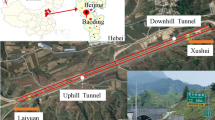Abstract
The steady three-dimensional airflow in a subway tunnel was analyzed using ANSYS CFX software by solving Reynolds-averaged Navier-Stokes equations. A ventilation system in a model subway tunnel was developed by analyzing the mass flow rate through the ventilation shafts and the airflow in the tunnel. The airflow in the tunnel and mass flow rate in the shafts were investigated with a guide vane, porous zone, and air-curtain installed in the subway model tunnel. A mechanical shaft of an existing subway tunnel in Seoul was analyzed to apply the developed ventilation system to the tunnel. The ducts of the mechanical shaft were connected in two different ways, and guide vanes were installed in the shafts. An emergency duct between the ducts of the mechanical shaft was used to connect the ducts and install the precipitator. An axial flow fan in the duct was used to induce swirling flow. Guide vanes were installed at one side and both sides of the shaft before the electric precipitator to obtain uniform flow, which enhances the performance of the precipitator. A proper duct connection for higher mass flow rate was obtained. The installation of guide vanes on both sides led to more uniform flow in the duct. The developed ventilation system was applied to the actual subway tunnel by connecting ducts and installing the guide vanes on both sides of the ducts.
Similar content being viewed by others
References
J. S. Jeon, J. W. Seo, M. J. Jeon, S. W. Eom and Y. Z. Chae, Indoor Radon levels in the subway cabins of the Seoul metropolitan area, Journal of Korean Society for Atmospheric Environment, 28 (2012) 374–383 (in Korean).
J. Modic, Fire simulation in road tunnels, Tunnelling and Underground Space Technology, 18 (2003) 525–530.
T. Ogawa and K. Fujii, Numerical investigation of threedimensional compressible flows induced by a train moving into a tunnel, Computers & Fluids, 26 (1997) 565–585.
T. Y. Chen, Y. T. Lee and C. C. Hsu, Investigations of pistoneffect and jet fan-effect in model vehicle tunnels, J. of Wind Engineering and Industrial Aerodynamics, 73 (1998) 99–110.
J. Li, H. Peng and S. J. Li, Numerical simulation of flow characteristics in bidirectional subway tunnel, Journal of Thermal Science and Technology, 5 (2006) 331–334.
F. Waymel, F. Monnoyer and M. J. P. William-Louis, Numerical simulation of the unsteady three-dimensional flow in confined domains crossed by moving bodies, Computers & Fluids, 35 (2006) 525–543.
H. L. Karlsson, L. Nilsson and L. Moller, Subway particle are more genotoxic than street particles and induce oxidative stress in cultured human lung cells, Chem. Res. Toxicol, 18 (2005) 19–23.
J. Song, H. Lee, S. Kim and D. Kim, How about the IAQ in subway environment and its management?, Asian J. of Atmospheric Environment, 2–1 (2008) 60–67.
ANSYS CFX, ANSYS Workbench, ICEM-CFD, CFX-Pre, CFX-Solver, CFX-Post User’s Manual (2009).
S. Gupta, M. Pavageau and J. C. Elicer-Cortes, Cellular confinement of tunnel sections between two air curtains, Building and Environment, 42 (2006) 3352–3365.
M. Juraeva, K. J. Ryu, S. H. Jeong and D. J. Song, Influence of mechanical ventilation-shaft connecting location on subway tunnel ventilation performance, J. of Wind Engineering and Industrial Aerodynamics, 119 (2013) 114–120.
F. R. Menter, Two-equation eddy-viscosity turbulence models for engineering applications, AIAA-J., 32 (1994) 269–289.
D. C. Wilcox, Comparison of two equation turbulence models for boundary layers with pressure gradient, AIAA Journal, 31 (9) (1993) 1414–1421.
M. Juraeva, K. J. Ryu, S. H. Jeong and D. J. Song, A computational analysis of the airflow in a twin-track subway tunnel with a sliding-curtain to improve ventilation performance, J. of Mechanical Science and Technology, 27 (8) (2013) 2359–2365.
Author information
Authors and Affiliations
Corresponding author
Additional information
Recommended by Associate Editor Seongwon Kang
Dong Joo Song received his B.S. degree in Seoul National University, and his M.S. and Ph.D. degrees in Aerospace engineering, Virginia Tech. He is now a professor at School of Mechanical Engineering, Yeungnam University. Professor Song’s research interests include CFD, Thermofluid system design, and aerodynamics.
Rights and permissions
About this article
Cite this article
Juraeva, M., Ryu, K.J., Jeong, SH. et al. Effect of guide vanes on recovering uniform flow in a ventilation duct in an existing twin-track subway tunnel. J Mech Sci Technol 29, 251–258 (2015). https://doi.org/10.1007/s12206-014-1231-y
Received:
Revised:
Accepted:
Published:
Issue Date:
DOI: https://doi.org/10.1007/s12206-014-1231-y




